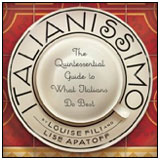Books |
Italianissimo: The Quintessential Guide to What Italians Do Best
Louise Fili & Lise Apatoff
By
Published: Jan 01, 2008
Category:
Travel
I can remember traveling to Italy when the dollar was strong and the lira was downtrodden. Trading dollars for lira was quite the jolly experience — at the currency exchange in Rome, you practically needed a shopping bag to carry a few hundred dollars in Italian money.
Now the Ferragamo is on the other foot. The Euro reigns supreme, and here in New York, some of the best restaurants and shops post their prices in dollars and Euros, for the convenience of our currency-advantaged foreign guests.
For the foreseeable future, Americans — well, my friends and I, anyway — might as well not have passports.
But if you think I’m going to say that my expedition to Arthur Avenue in the Bronx is as satisfying as dinner in the Roman ghetto, dream on. If I want to time travel, I have to conjure the smell of wood smoke on a Tuscan evening or translate a cab horn to the madness of traffic in Rome.
It’s easier to keep my eyes open and do some smart importing of Italian products and culture — like watch movies like The Conformist.
Or with the help of “Italianissimo: The Quintessential Guide to What Italians Do Best,” I can do some delightful armchair traveling.
It doesn’t take much to get me dreaming, so I don’t want a thick tome. This nice square book, with glorious photos and great design, is itself very Italian — and, like a serving of pasta at Dal Bolognese in Rome, just enough to satisy.
The book is a list of 50 categories. Each gets a two-page spread: smart text, full-page photo. Like a luxury magazine, only on a single subject — the glory of the Italian spirit.
[To buy “Italianissimo: The Quintessential Guide to What Italians Do Best” from Amazon, click here.]
Balsamic Vinegar — in the fine print, there’s a description of a vinegar-inspired restaurant in Modena with only four tables.
Il Caffé — always good to be reminded that Italians never order cappuccino after dinner. “It impedes the digestion.” Espresso only, please! (And how nice that the authors agree that Sant’Eustachio coffee is indeed the best.
Il Capodanno — why red underwear is a hot item in December. (It wards off the evil eye.)
I Gesti Italiani — a guide to hand gestures.
La Gondola — did you know it takes 500 hours and 7 types of wood to make one? And that they’re custom-built to work with the individual gondolier’s weight?
La Mezzaluna — the half-moon kitchen utensil. Safer than a knife and more efficient.
Pizza — Why was the original called marinara? In honor of hungry fishermen, who craved it when they came ashore.
But let me serve one large helping. Here’s the entire entry for a beloved car. I knew nothing:
LA CINQUECENTO (The Fiat 500)
What is the subject of a love song, a character in an animated film, and has doors that make men weep? The Fiat 500, of course. In the 1930s, while England had the Morris 8 and Germany the Volkswagen, Mussolini’s Italy was experiencing vehicle envy. To address the problem, Fiat chairman Giovanni Agnelli summoned his engineers to create a car for the masses. After the head designer came up with a model that caught fire on its test run (with Agnelli in tow) he was summarily dismissed, and Dante Giacosa was brought on board. His solution, the 500, was introduced with great fanfare in 1936, and dubbed Topolino (Mickey Mouse) for its disarming cuteness. An overnight sensation, it was able to conquer winding medieval roads as well as hopeless parking situations. The rear-engined Nuova Fiat 500, or Cinquecento, was introduced in 1957, featuring reverse-opening “suicide doors” which were later discontinued-much to the disappointment of many an Italian male who could no longer gawk at the shapley legs of a signora entering and exiting the car. Although production ceased in 1975, making it a coveted collector’s item, the Cinquecento made a triumphant reappearance in 2007, on the fiftieth anniversary of its auspicious debut.
Good enough to eat, yes?
To read more about Gustiamo imported foods, click here.
To buy “City Secrets: Rome” from Amazon.com, click here.
To buy “City Secrets: Florence, Venice & the Towns of Italy” from Amazon.com, click here.
To buy “The Food and Wine Guide to Naples and Campania” from Amazon.com, click here.
To buy “The Food Lover’s Companion to Tuscany” from Amazon.com, click here.
To buy “The Civilized Shopper’s Guide to Rome” from Amazon.com, click here.
To buy “The Civilized Shopper’s Guide to Florence” from Amazon.com, click here.
To buy “A Culinary Traveller in Tuscany: Exploring & Eating Off The Beaten Track” from Amazon.com, click here.


